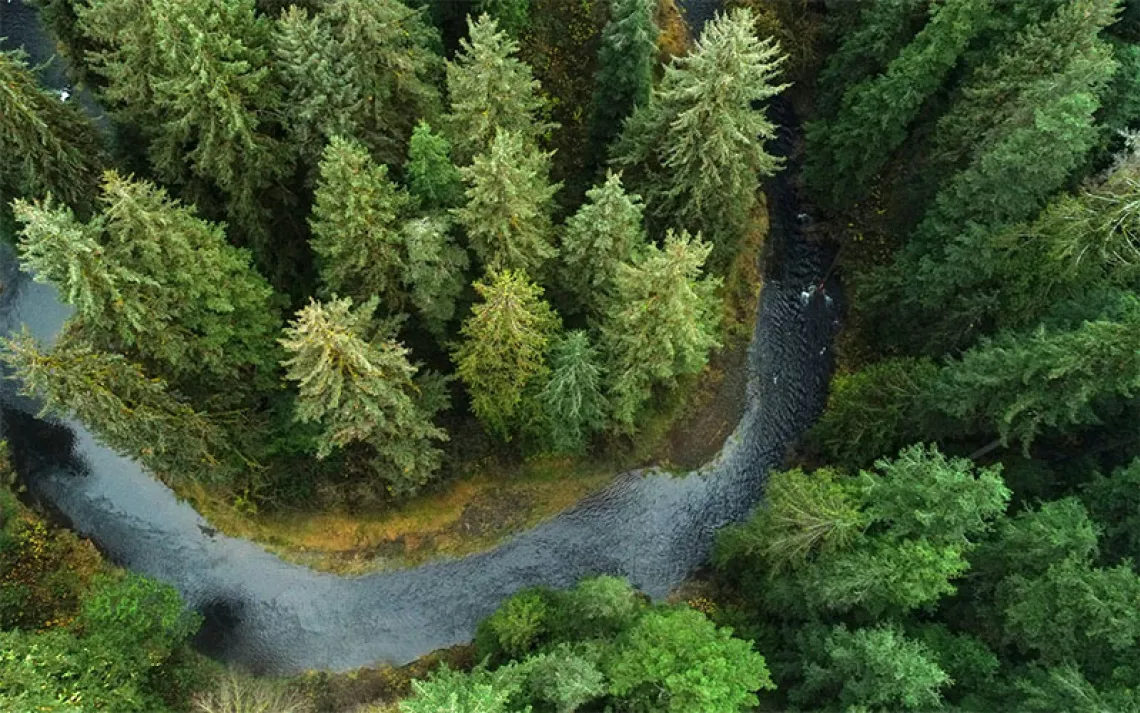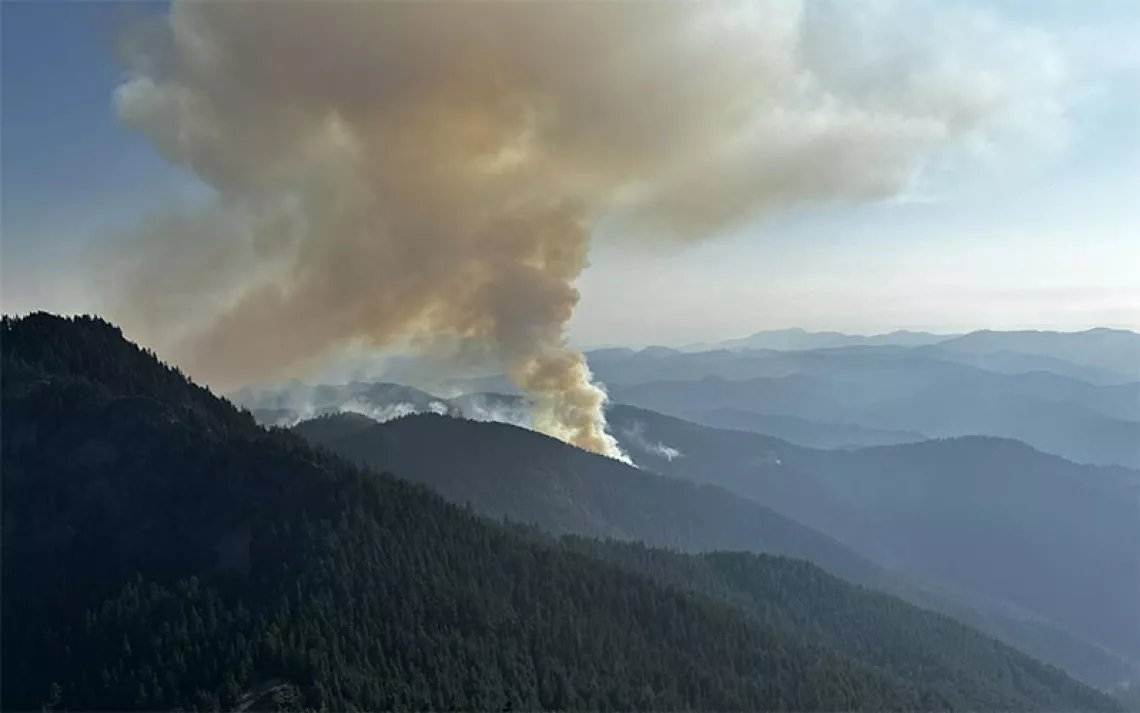Thousands of Brazilians March to Demand Action on Amazon Fires
As President Bolsonaro waffles, grassroots groups call for international solidarity

Photo by Michael Fox
The Amazon rainforest is burning, and the most impassioned firefighters have come from a perhaps unlikely place—Brazil’s cities, where, in recent days, thousands of citizens have hit the streets to demand that the Brazilian government take swift action to halt deforestation.
During the previous weekend, marchers took to the streets in dozens of cities across the South American nation. In São Paulo, forest defenders blocked the main drag, Paulista Avenue, and called for the resignation of Environment Minister Ricardo Salles, who has overseen major cuts to Brazil’s environmental regulatory agencies. In Rio de Janeiro, thousands marched on the city’s iconic Ipanema Beach. As darkness fell, they lifted their cellphones into the air, which sparkled across the crowd like thousands of glittering stars.
“I feel completely destroyed. I feel like a part of me has been burning,” said Luiza Goldinho Vieira, a chemistry student who attended a march in Florianopolis, the capital of the southern state of Santa Catarina, on Monday.
Protesters at the front of the Florianopolis march balanced a huge inflatable blue globe above their heads. “Amazon, yes. Bolsonaro, no,” they chanted.
The forest defenders’ anger is focused on President Jair Bolsonaro, who many people criticize for having encouraged the forest clearing that is behind the fires. Bolsonaro is a former army officer who served during Brazil’s military dictatorship. Since taking office in January, he promised to fulfill his campaign promises of opening up the Amazon for increased development—including mining, logging, cattle ranching, and soy production—and ending any new recognition of Indigenous lands. The president’s opponents say that his rhetoric and the gutting of environmental regulatory agencies under his government, has spurred farmers, loggers, and other land grabbers to accelerate their push into the rainforest.
“They said there would be no more fines for those who set fire or cut down trees, and that’s what happened here,” says an organic farmer from Acre state, Jesuina Alves Braga. “Everything we had was burned. People were empowered, and that’s what they did—set their fires without worrying if it would impact their neighbor or not."
In Brazil, farmers often set fires to their land during the dry season in order to clear pastures. Large landowners, loggers, and land grabbers also use burning to extend their reach into the rainforest. Brazil has now registered more than 74,000 fires since the beginning of the year—an 84 percent increase in fires from 2018 (though the number is still far below the number that occurred in 2005, when deforestation in the Brazilian Amazon hit an all-time high).
The current fires are no accident.
Now is the time for environmental journalism.
Sign up for your Sierra magazine subscription.

In early August, a group of at least 70 farmers, land grabbers, and businessmen in the Brazilian state of Para began organizing over the social messaging application WhatsApp for what they called the "Day of Fire.” The organizers pledged that on August 10, they would set fire to the shoulders of the BR-163 interstate highway to show their support for President Bolsonaro and his policy of weakening environmental inspections and fines. An ad was taken out in a rural Para state newspaper, Folha do Progresso, calling on others to join in the action in areas across the state.
Brazil’s environment agency, IBAMA, which is charged with ensuring compliance of environmental laws, was alerted of the plans day in advance. It requested support from the Justice Ministry. Nothing was done.
August 10 arrived. Fires erupted across Para. It was the largest number of mass blazes at the same time in the history of the state. Satellite monitoring detected 1,457 separate fires in 15 municipalities in Para state alone.
Other agribusiness interests across the Amazon region followed Para’s lead. At one point last week, 2,500 fires were blazing across the country.
As the news about the fires has spread around the world, stories of the damage done to the forest ecosystem and the suffering of human victims have begun to emerge. In the state of Acre, fires destroyed the Huwã Karu Indigenous Cultural Center. In one picture, an Indigenous man and woman in Western clothing stand on a path belonging to the center. Surrounding them is a charcoaled forest, black and dead, still smoldering from the blaze. The community is now collecting donations to rebuild.
In one video that has been shared widely on social media, a leader of the Xingu people, wearing a crown of tall yellow feathers across her head, promises to resist. Members of her tribe stand behind her. The Xingu land has been one of the top 12 Indigenous territories most impacted by the fires, according to a study by Instituto Socioambiental, a Brazilian environmental NGO.

Fire consumes the Amazon rainforest in Altamira, Brazil, in August 2019. | Photo by Leo Correa/AP Photo
As of August 20, more than 3,500 fires had burned on 148 Indigenous territories in the Brazilian Amazon. A third of the total blazes across the Amazon were on protected Indigenous lands.
“We’ve been sneezing and coughing. We’ve had trouble breathing, because of the smoke,” Chief Andre Karipuna, from the Karipuna territory outside of Porto Velho in the state Rondonia, told Sierra. He said most of their territory had not been touched, but that illegal land grabbers had set fire to at least one section of their land, which they had already illegally cleared.
The international dismay over the fires and the increasing domestic opposition appear to have forced President Bolsonaro to finally acknowledge the seriousness of the situation. On Friday, August 23, Bolsonaro ordered 44,000 troops to battle the flames and to crack down on criminal activity behind the fires. In a televised address, he told the country that the Amazon was “an essential part of our history, our territory and everything that makes us feel Brazilian.” He said, “The protection of the forest is our duty.”
It was a forced about-face. During the previous week, as the flames whipped across Amazonia, Bolsonaro denied and deflected. He said the attention on the fires was a conspiracy to attack his government. He claimed he didn’t have the resources to respond. Environment Minister Ricardo Salles called the fires “environmental sensationalism.” Without evidence, Bolsonaro blamed the blazes on NGOs, who he said could have set the fires to get back at his government for funding cuts. (In response, 118 Brazilian NGOs wrote a joint letter demanding accountability for the accusations.)
While such claims seem preposterous, they fit within a long-held Brazilian myth that holds that foreign countries are out to swindle Brazil from the Amazon and its riches. “I don’t really think that these fires make that much of a difference for the climate,” Ezequiel da Costa, a 30-year-old street vendor in the city of Florianopolis, told Sierra. “I do think it’s a question of NGOs, and I support President Bolsonaro."
In Brazil, false news and misinformation often spreads with the speed of a forest fire. Rumors and conspiracies appear seemingly out of nowhere and then are peddled and promoted by a network of pro-Bolsonaro YouTubers and social media influences—and sometimes by Bolsonaro himself. This has also happened with the Amazon fires. In the mid-afternoon of Monday, August 19, thick smoke from the burning fires so completely covered the skies of São Paulo that street lamps flickered on. One prominent conservative YouTuber told viewers, in a video that has accumulated nearly 700,000 views, that the smoke came from Bolivia. Another YouTuber claimed NASA, which is monitoring the fires, could have mistaken clouds for smoke. One supposed expert claimed that it was “impossible” to burn the Amazon.
Brazilian political observers say international pressure was key in forcing Bolsonaro to finally address the blazes. Ireland and France promised to block the ratification of the EU-Mercosur free-trade deal—which was recently agreed to after 20 years of negotiations—if Brazil did not act to protect the forest. Finland has called on the EU to suspend the import of Brazilian beef—a major export. Such continued pressure will be key to reversing the recent increase in deforestation.
“It’s not just us that have to take action, but other countries as well,” says Selvino Neckel, an ecology professor at the Santa Catarina Federal University, who spent 13 years working in the Amazon. “Because a substantial number of the world’s countries buy materials that come from the Amazon or Brazil.”
Some Indigenous communities have, in the past, called for a boycott of products such as wood, soy, and meat. These commodities, which often come from the Amazon or from land that was recently cleared, are frequently drivers of deforestation and fuel the encroachment of powerful interests onto protected lands.
In a recent report, "Complicity in Destruction II," Oakland-based Amazon Watch highlighted how Northern consumers, as well as major US and EU soy companies, are fueling Bolsonaro’s assault on the Amazon.
“You have to consume consciously,” Carlos Durigan, Brazil’s director of the Wildlife Conservation Society, told Sierra. He believes a boycott is too much, but that consumers abroad have to pay attention to the source of the products they are purchasing, to make sure they are sustainable and not fueling the destruction of the Amazon.
Cleber Buzatto, the executive secretary of Brazil’s Indigenous Missionary Council, said people from the United States should lobby their elected representatives to pressure Brazil. “The Bolsonaro government has completely aligned itself with the Trump administration, so peoples’ ability to question Bolsonaro’s handling of the Amazon together with their elected officials would be very important at this moment,” he said.
The ultimate effectiveness of such actions will be measured by whether they can force Bolsonaro to move away from his Amazon development agenda. Even if Brazil’s armed forces are now fighting the blazes and prosecutors are investigating those responsible for the “Day of Fire,” Bolsonaro has not yet turned his back on his very clear vision for the Amazon.
“Twenty million Brazilians live in that region [the Amazon], and they have been waiting for a dynamic economy proportional to the riches there,” Bolsonaro told the country in his Friday night national address. “To protect the Amazon, operations of monitoring, inspections, and control are not enough. We need to give the population there the opportunity to develop with the rest of the country.”
After the rainy season resumes, the fires will die down and the international media will, for the most part, look away. But the drive to open up the region will remain. That’s a promise Bolsonaro is unlikely to set aside any time soon.
 The Magazine of The Sierra Club
The Magazine of The Sierra Club



